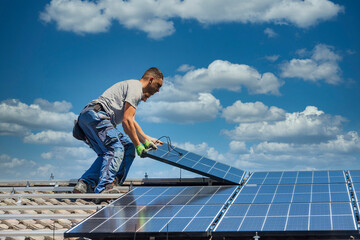
The demand for clean, renewable energy has never been higher, and solar installation is at the forefront of this movement. Homeowners and businesses are turning to solar power not only to reduce energy bills but also to create a more sustainable future. With advancements in technology and growing awareness of environmental impact, solar installation has become one of the most effective investments for long-term energy savings.
This guide explains the benefits, process, and key considerations of solar installation to help you understand why switching to solar can be a game-changer.
Why Solar Installation Is a Smart Choice
Solar energy provides countless advantages for both property owners and the environment. By installing solar panels, you can:
- Lower energy costs – Once installed, solar systems can significantly reduce or even eliminate monthly electricity bills.
- Increase property value – Homes and buildings with solar systems often attract higher resale values.
- Reduce environmental impact – Solar power is a clean, renewable energy source that lowers carbon emissions.
- Enjoy energy independence – Producing your own electricity reduces reliance on traditional energy providers.
- Long-term savings – With proper maintenance, solar panels can last decades, offering reliable energy for years to come.
How Solar Installation Works
Understanding the installation process can help you appreciate the value of switching to solar. While each system may vary, most solar installations follow these steps:
1. Site Evaluation
A solar professional inspects your property to determine whether it receives adequate sunlight. They evaluate roof condition, angle, and shading from nearby trees or structures.
2. System Design
Based on your energy needs, the solar system is designed to maximize efficiency. Factors like panel type, placement, and system size are considered during this stage.
3. Permitting and Approvals
Before installation, necessary permits and approvals are secured to ensure the system complies with building codes and regulations.
4. Installation of Panels
The panels are mounted on the roof or ground and connected to the system. Proper positioning ensures they capture the maximum amount of sunlight.
5. Electrical Connection
The solar panels are connected to an inverter, which converts solar energy into usable electricity for your home or business.
6. Inspection and Activation
Once installed, the system undergoes final inspections before being activated. At this point, you can begin producing clean, renewable energy.
Types of Solar Systems
Not all solar installations are the same. Different systems suit different energy needs and property types. Here are the most common options:
- Grid-tied systems – These remain connected to the local power grid, allowing you to use solar power while still having access to traditional electricity. Excess energy can often be sent back to the grid.
- Off-grid systems – Ideal for remote locations, these systems store energy in batteries, providing independence from the grid.
- Hybrid systems – Combining the best of both worlds, hybrid systems use solar panels and batteries but can still connect to the grid when needed.
Benefits of Professional Solar Installation
While DIY kits exist, professional solar installation offers significant advantages:
- Expertise and precision – Professionals ensure panels are placed for maximum sunlight exposure.
- Proper electrical connections – Trained installers guarantee safe and efficient wiring.
- Compliance with codes – Professional installation meets all legal and safety requirements.
- Long-term reliability – Professionally installed systems last longer and require fewer repairs.
- Warranties and support – Many installers provide service guarantees for added peace of mind.
Key Considerations Before Installing Solar
Before committing to solar installation, there are important factors to evaluate:
- Roof condition – Ensure your roof is in good shape, as solar panels last for decades.
- Sun exposure – Properties with minimal shading and southern-facing roofs maximize solar potential.
- Energy needs – Review past electricity bills to determine the size of the system required.
- Budget and financing – While solar installation is an investment, many options exist to make it affordable.
- Local climate – Even in less sunny regions, solar panels can still generate significant power.
Maintenance Tips for Solar Systems
One of the major advantages of solar panels is that they require minimal maintenance. However, following these steps helps keep your system running efficiently:
- Regular cleaning – Remove dust, dirt, and debris that may block sunlight.
- Check for shading – Trim trees or branches that may grow and cast shadows on panels.
- Monitor system performance – Many solar systems include monitoring tools to track energy output.
- Professional inspections – Schedule routine checkups to ensure wiring, inverters, and panels remain in good condition.
The Future of Solar Installation
Solar energy continues to grow rapidly worldwide as more people recognize its benefits. With technology improving efficiency and affordability, solar installation will only become more accessible in the future. Homeowners and businesses who adopt solar now are not only saving money but also contributing to a cleaner, greener planet.
Solar installation is more than just an energy upgrade—it’s an investment in the future. From reducing energy bills and increasing property value to promoting sustainability, solar power provides lasting benefits. With the right system, professional installation, and minimal maintenance, solar panels can supply reliable energy for decades.
Making the switch to solar is a smart move for both financial savings and environmental responsibility. By harnessing the power of the sun, you can enjoy clean energy, lower costs, and a brighter future.